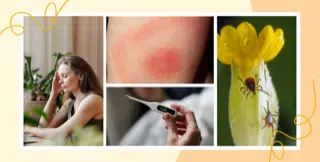This month’s topic might make your skin crawl, but we promise it’s all with good intentions! It’s that time of the year again…tick season. But what is the danger of ticks? Ticks are known to be possible carriers of disease. One of the most common is Lyme disease, which is causes by the bacterium borrelia burgdorferi. This disease is transmitted to humans through the bite of an infected black legged tick.1 Lyme disease is not contagious but can be very serious if not treated correctly or in a timely manner.4 Early symptoms, 3-30 days after a bite, include fever, headache, fatigue, chills, muscle and joint pain, swollen lymph nodes, and the most common one, a skin rash called erythema migrans. This rash occurs in 70-80% of infected persons, is warm to the touch but rarely itchy or painful, can reach up to 12 inches, and clears in the middle and looks like a bullseye as it gets bigger. The rash typically starts at the area of the bite but may appear on any area of the body. Symptoms that appear days to months after bitten include severe headaches, neck stiffness, facial palsy, arthritis paired with severe joint pain and swelling, intermittent pain in tendons, muscles, joints, and bones, heart palpitations, episodes of dizziness, shortness of breath, inflammation of the brain or spinal cord, nerve pain, or shooting pain, numbness, or tingling in the hands or feet.2 If you are experiencing any of these symptoms and could have been exposed to a tick bite, you need to see a doctor. Lyme disease is typically treated with 2-3 weeks of antibiotics, but treatment may differ depending on age, severity of disease, how long the symptoms have been present, and how the person’s body responds to it.1 If this disease is not treated, it can spread to the joints, heart, and nervous system. It is often recommended to take a course of antibiotics if you even suspect you’ve been bitten since Lyme can lie dormant in the body and have significant long-term effects if not treated.
Fortunately, there are ways to prevent tick bites. Since not going outside is not an option for a healthy lifestyle, here are some things to help you prepare and be smart when you’re out in nature. Wear light-colored clothing with a tight weave to spot ticks easily and closed shoes, long pants, and a long-sleeved shirt. The least amount of exposed skin, the better. Check clothes and exposed skin frequently and consider using a tick repellent. If repellent is a turn off for you because of the chemicals, there are plenty of natural repellent options out there including cedar oil spray, eucalyptus oil, neem oil, apple cider vinegar and more. Stay on cleared, well-traveled trails, walk in the center of trails, and avoid dense woods or bushy areas. Avoid sitting directly on the ground or stone walls and tie long hair back, especially when gardening. When returning indoors, shower as soon as possible and do a full body check on yourself and any kids or pets, removing ticks immediately if found.5 The best way to do so is grasping the mouth area of the tick with tweezers and pulling firmly and steadily upward. Be careful not to squeeze, crush, or puncture its body as it may contain infectious fluids.9 It is also a good idea to save the tick in a plastic bag should you need to have the tick tested for Lyme. Ticks generally can’t transmit disease unless it has been attached to a human longer than 36 hours, so it’s important to find and remove them ASAP.4
Although Lyme disease is the most common tick-borne disease, it is not the only one out there. Anaplasmosis, ehrlichiosis, babesiosis, Powassan virus disease, and rocky mountain spotted fever are a few other examples. Anaplasmosis and ehrlichiosis symptoms are similar to Lyme disease’s: fever, muscles aches, weakness, headache, nausea, vomiting, and joint pain. However, these diseases typically don’t come with a rash. Babesiosis is a rare disease that usually has no symptoms, directly affects the red blood cells, and can cause anemia. There are some recorded cases that included flu-like symptoms. Severe cases can cause blood clots, organ failure, and unstable blood. Doctors diagnose these diseases through symptoms, awareness of a tick bite, and a blood test. Powassan virus disease is rare and has a range of mild flu-like symptoms to life threatening encephalitis (inflammation of the brain). Lastly, rocky mountain fever is also rare but can become extremely fatal within eight days of symptoms if not treated. Symptoms can include rash on palms of hands and soles of feet, abdominal pain, vomiting, muscle pain, and headaches.9
References:
1 https://www.cdc.gov/lyme/index.html
2 https://www.cdc.gov/lyme/signs_symptoms/index.html
3 https://www.hopkinsmedicine.org/health/conditions-and-diseases/lyme-disease/ticks-and-lyme-disease
5 https://www.health.ny.gov/diseases/communicable/lyme/
6 https://www.health.ny.gov/diseases/communicable/ehrlichiosis/fact_sheet.htm
7 https://www.health.ny.gov/diseases/communicable/babesiosis/fact_sheet.htm
8 https://www.health.ny.gov/diseases/communicable/powassan/index
9 https://www.health.ny.gov/diseases/communicable/rocky_mountain_spotted_fever/fact_sheet.htm

